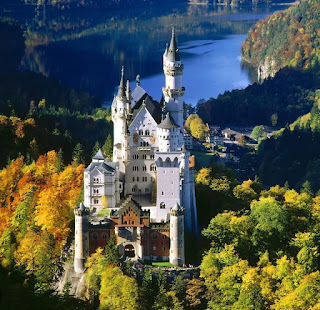"It is my intention to rebuild the old castle ruin of Hohenschwangau near the Pöllat Gorge in the authentic style of the old German knights' castles, and I must confess to you that I am looking forward very much to living there one day."
— Ludwig II, Letter to Richard Wagner, May 1868=====================================================================
(near Fussen in Bavaria, Germany) Schloss Neuschwanstein (Neuschwanstein Castle) was built atop a rock ledge over the Pöllat Gorge in the Bavarian Alps by order of Bavaria’s King Louis II. Construction began in 1868. Louis II had spent much of his childhood at Hohenschwangau Castle, a neo-Gothic, medieval-inspired castle decorated with scenes from legend and poetry. After his accession to the throne in 1864, Louis set out to build a “New Hohenschwangau Castle,” which he intended to be a better reproduction of a medieval-style castle in line with his fairy-tale vision of monarchy. The Romanesque designs were drawn by scene painter Christian Jank, and these were translated into architectural plans by Eduard Riedel.
+ Neuschwanstein stands on the site of two smaller castles, the ruins of which were cleared away in 1868. The foundation stone for Neuschwanstein was laid in September 1869. Although Louis expected the project to be completed within three years, only the gateway building was inhabitable by 1873. The topping-out ceremony was held on 29 January 1880, though the castle was still under construction. The castle remained incomplete in 1886, when Louis died by drowning himself. He had lived there, off and on, only some six months in total. Several weeks after his passing, the unfinished castle was opened to the public as a museum. (Only about a dozen rooms were ever finished).
+ Known as a castle of paradox, Neuschwanstein was built in a time when castles were no longer needed as strongholds, and, despite its romanticized medieval design, Louis also required it to have all the newest technological comforts. The structure is complete with a walled courtyard, an indoor garden, spires, towers, and an artificial cave. The castle is equipped with running water throughout, including flush toilets and hot water in the kitchen and baths, and has a forced-air central heating system. The dining room is serviced by an elevator from the kitchen three stories below. (Louis even made sure the castle was connected to telephone lines, though at the time of its construction very few people had telephones.)
+ Appearing through the mountaintops like a mirage, Schloss Neuschwanstein was the model for Disney’s Sleeping Beauty castle. King Ludwig II had envisioned it as a giant stage on which to recreate the world of Germanic mythology, inspired by the operatic works of his friend Richard Wagner. The most impressive room is the Sängersaal (Minstrels’ Hall), whose frescos depict scenes from the opera Tannhäuser.
+ For a great view of Neuschwanstein and the plains beyond, walk up to Marienbrücke, which spans the Pöllat Gorge over a waterfall just above the castle.





No comments:
Post a Comment